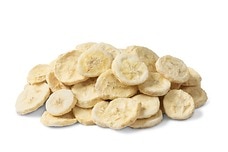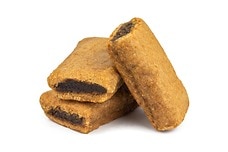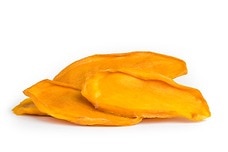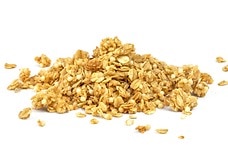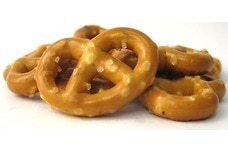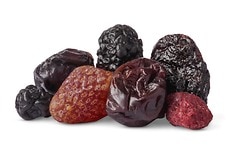Are Carbs Making a Comeback? The Low-Fat, High-Carb Diet
With the rise of the Atkins Diet in the 1990s, carbs fell out of favor -- and they fell hard. For the past few decades, “carbohydrate” has become a dirty word in weight loss circles. Now, however, some nutrition experts are revisiting scientific evidence that suggests that carbohydrates aren’t so bad after all. It all just depends on the type of carbs you eat.
Deconstructing Carbs: What Is a Carbohydrate?
There are three major types of macronutrients that your body uses for energy: protein, fats, and carbohydrates. Carbohydrates are made from long strings of molecules called saccharides (European Food Information Council, 2012). Simple carbohydrates contain just one saccharide (this compound is called a monosaccharide) or two saccharides (a disaccharide). Monosaccharides and disaccharides are commonly known as sugars. For example, glucose is a monosaccharide while sucrose (table sugar) is a disaccharide.
Longer strings of saccharides, called polysaccharides, are also commonly found in foods. Foods that contain primarily polysaccharides are often known as complex carbohydrates. There are two major forms of polysaccharides in the foods we eat: starches and fiber. Because of their complex structure, starches are more difficult for the body to break down than simple sugars (European Food Information Council, 2012). Dietary fiber, on the other hand, is not digested by the body but promotes gastrointestinal health.
Purpose of a Low-Fat, High-Carb Diet
Carbohydrates are the body’s primary source of energy. When available, the body will burn carbohydrates to fuel its physiological processes. Only when carbs are unavailable will the body engage in fat burning. Thus, the low-carbohydrate diet orthodoxy says that you must cut out carbohydrates to allow your body to burn fat. However, proponents of the high-carbohydrate diet say that even a low-carb diet can trigger hormonal changes that may promote unhealthy fat absorption by cells. With a high fat diet, as opposed to one that is low-fat, there are more fats readily available so as to increase overall fat absorption (Harvard T.H. Chan School of Public Health, 2015 ; Hall et al., 2015 ; Willett & Ludwig, 2013). Thus, eating a high-carbohydrate diet that is low in fat may actually provide a more beneficial way of burning excess fat.
Scientific Evidence Supporting the High-Carb Diet
Recent evidence from a study conducted by the National Institutes of Health found that a high-carb, low-fat diet was associated with greater fat loss compared to plans that restricted carbohydrate consumption (Hall et al., 2015). In the study, obese individuals received the same amount of calories from a diet that was either high-carb and low-fat or high-fat and low-carb. The people on a high-carbohydrate diet lost more body fat than those who were restricting their carbohydrate intake. Even though people who following a high-fat, low-carb diet showed increases in their fat burning, this was not enough to overcome the increased fat intake of a low-carb diet (Hall et al., 2015).
Another large study, the Women’s Health Initiative Study, also examined dietary patterns to determine their effect on weight and health. The study found that among women, those who followed a low-fat, high-carb diet lost weight over a seven-year follow-up period (Howard et al., 2006). Collectively, the available scientific evidence supports the idea that a high-carbohydrate diet can be appropriate for people trying to lose weight or maintain a healthy weight.
Meal Planning for a High-Carb Diet
When planning a high-carbohydrate diet, it is all about the types of carbohydrates you choose (Harvard T.H. Chan School of Public Health, 2015). Many people know to avoid simple carbohydrates, which can cause blood glucose levels to spike. However, starchy carbohydrates such as potatoes or highly processed carbs can also cause alterations in blood glucose levels. These foods are considered high glycemic index (GI) foods, meaning that they have a relatively high impact on blood glucose levels. Instead, people on a high-carbohydrate diet are encouraged to choose carbohydrates from low GI sources. This includes carbohydrates in a more “natural,” unprocessed state.
When planning meals for a high-carbohydrate, low-fat diet, make sure to avoid the following foods because of their high levels of simple and refined carbohydrates (European Food Information Council, 2012):
- White bread
- Potatoes
- Cornflakes
- Rice crackers
- Fruit juice
- White rice
Instead, foods that are high in good carbohydrates, such as whole fruits, non-starchy vegetables (e.g., artichoke, broccoli, leafy green vegetables, eggplant, Brussels sprouts, tomatoes, cucumber), legumes (e.g., chickpeas, black beans, kidney beans), and nuts (Harvard T.H. Chan School of Public Health, 2015). Whole grain products such as quinoa, amaranth, buckwheat, steel cut oats, muesli, barley, or wheat bran are other good choices.
Of course, the low-fat part of the diet is just as important as the high carbohydrate intake. One of the reasons that it is beneficial to keep fat intake to a minimum is that fats have 9 calories per gram, while carbohydrates have just 4 calories per gram. Thus, you will consume more calories -- and thus be more likely to gain weight -- from high-fat foods compared to a similar portion size of high-carbohydrate foods. Some of the high-fat foods to avoid include (Harvard T.H. Chan School of Public Health, 2014):
- Full fat dairy products
- Butter
- Cheese
- Creamy canned soups
- Processed baked goods
- Lamb
- Pork
- Fatty beef
- Skin-on chicken
- Ice cream
- Pizza
Again, a diet that is high in whole fruits, non-starchy vegetables, and whole grain products is naturally low in fat. Swapping nonfat dairy products for full fat is a good way to decrease your dietary fat consumption. Also try to avoid processed foods as much as possible, as these are more likely to contain healthy saturated or trans fats as well as simple carbohydrates.
Considerations When Starting a High-Carb Diet
As with all diets, moderation and balance are important. For example, a high-carb diet that includes a lot of simple sugars is likely to have a deleterious impact on your blood glucose levels. When eating a diet high in simple carbohydrates, your body may become resistant to insulin. This increases your risk for type 2 diabetes. More scientific evidence is needed to determine if type 2 diabetes is a common long-term effect of a high-carb, low-fat diet.
It is also important to ensure that of the fats you do eat, they come from healthy sources. Saturated or trans fats are unhealthy fats that are often found in processed foods, baked goods, and animal products. In contrast, monounsaturated and polyunsaturated fats are healthy fats (Harvard T.H. Chan School of Public Health, 2014). Getting enough of these fats can lower your levels of “bad” LDL cholesterol while increasing your levels of “good” HDL cholesterol. Monounsaturated and polyunsaturated fats are found in nuts, seeds, avocados, olive oil, flaxseeds, and fatty fish. When following a high-carb, low-fat diet, try to keep fat intake to a minimum. When you do eat dietary fat, however, prioritize getting polyunsaturated and monounsaturated fats.
Low-Fat, High-Carb Recipes
The following recipes offer carbohydrates from whole foods to supply dishes that emphasize healthy carbs and unsaturated fats over trans fats, saturated fats, and refined carbohydrates.
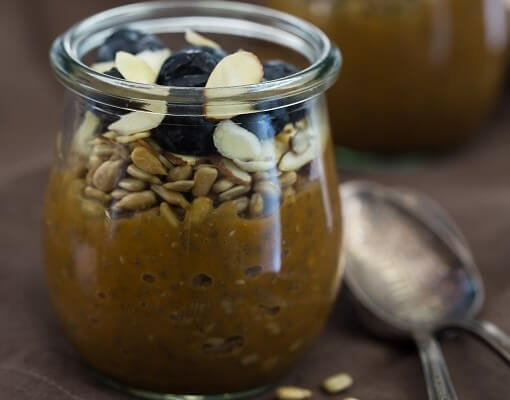
Pumpkin Chia Seed Pudding Recipe
This palatable pumpkin pudding provides a palpable portion of carbohydrates from whole, natural foods. The same serving also supplies less than 2 grams of saturated fat per serving and less than 8 total grams of fat to provide the perfect provision of energy to fuel your morning.
Ingredients: Milk, pumpkin puree, chia seeds, maple syrup, pumpkin spice, sunflower seeds, sliced almonds, fresh blueberries.
Total Time: 10 minutes
| Yield: 4 servings
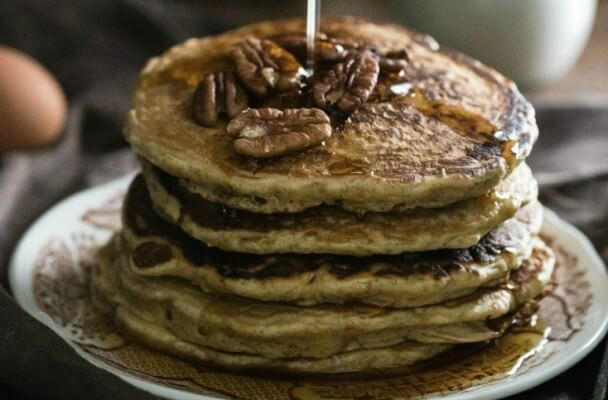
Quinoa Pancakes Recipe
For a heartier breakfast, our quinoa pancakes are an idyllic way to carbo load before a long, laborious day. Each serving contains less than 4 grams of total fat with less than a gram from saturated fat, meanwhile that same serving of flapjacks contains more than 35 grams of carbs!
Ingredients: Quinoa, whole wheat pastry flour (or brown rice flour for gluten-free cakes), eggs, milk, maple syrup or honey, raw pecans, baking powder, vanilla extract, salt.
Total Time: 15 minutes
| Yield: 7 pancakes
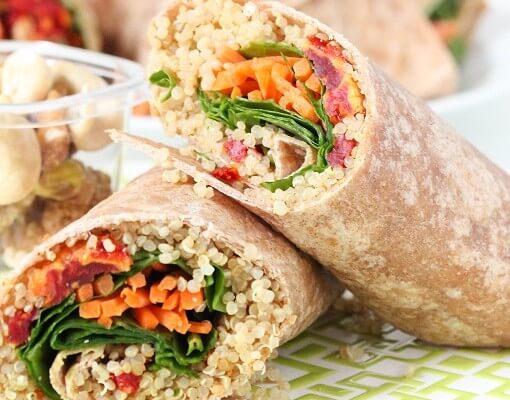
Quinoa Veggie Wrap Recipe {vegan}
Treat yourself to a filling wrap that is packed to the brim with nutritious veggies and superfoods. This ingenious snack provides a preponderance of energy from the potent quinoa and whole grain wrap, while the hummus inside serves to add flavor and structure without upping fat intake.
Ingredients: Tortilla wraps, quinoa, hummus, fresh spinach, sun-tomatoes, shredded carrots.
Total Time: 30 minutes
| Yield: 4 wraps
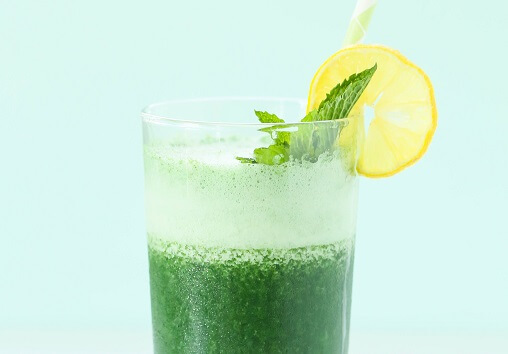
Spirulina Smoothie Recipe
A simple smoothie you can enjoy anytime, the tart taste of lemon and apple pairs perfectly with the superfood seaweed that powers the drink. Spirulina is known for its protein and vitamin content. Though not particularly high in carbs, the delicious drink contains less than a gram of fat.
Ingredients: Spirulina, banana, fresh spinach, apple juice, crushed ice, lemon juice.
Total Time: 2 minutes
| Yield: 2 smoothies
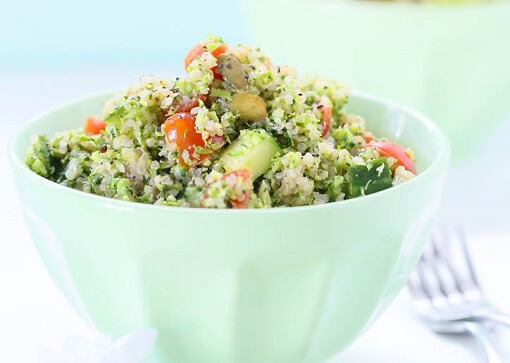
Broccoli Quinoa Salad Recipe {gluten-free}
A superb salad to pair with a protein packed dinner or to serve as a standalone lunch dish, this combination of quinoa and broccoli supplies vitamins, minerals, and complex carbohydrates to meet your health needs. The mixture also contains only a modest 2 grams of saturated fat per serving.
Ingredients: Fresh broccoli, quinoa, cucumber, cherry tomatoes, raw pumpkin seeds, sea salt, black pepper, Dijon mustard (optional), vinegar, extra virgin olive oil, maple syrup.
Total Time: 1 hour
| Yield: 8 servings
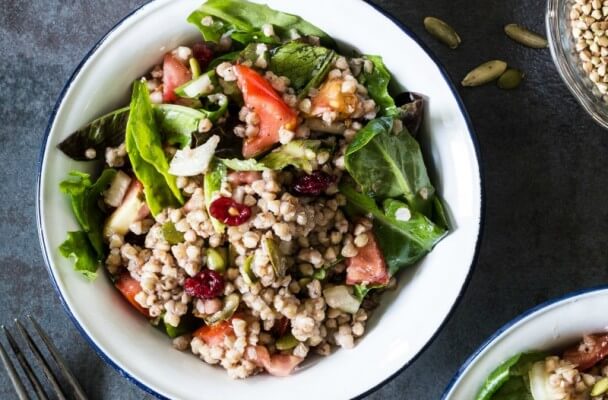
Buckwheat Salad Recipe
Like quinoa, buckwheat is a seed that resembles a grain- acting as a source of protein, fiber, and slow-digesting starches. Combined with mixed greens and seeds, the salad does contain a fair amount of healthy unsaturated fats, but limits saturated fats to less than 2 grams per serving.
Ingredients: Mixed greens, buckwheat, tomatoes, onion, raw pumpkin seeds, dried cranberries, rice wine vinegar, sesame oil, salt, black pepper.
Total Time: 15 minutes
| Yield: 5 servings
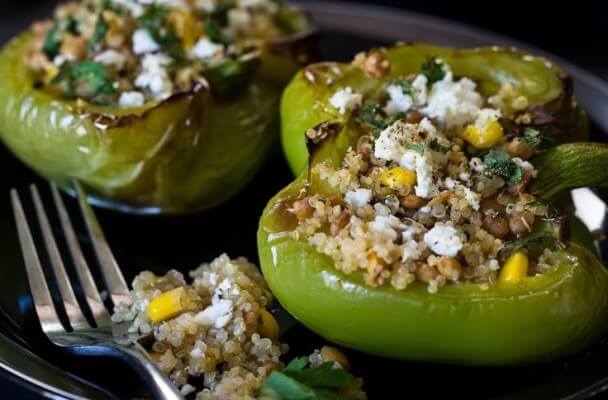
Quinoa Stuffed Peppers Recipe {gluten-free}
A delectable dinner dish for those seeking something starchy with minimal fat, these stuffed peppers provide more than 85 grams of carbohydrates per serving. While it also serves up 7.5 grams of total fat, less than 2 grams are from saturated fat and whole foods define the dish.
Ingredients: Quinoa, green bell peppers, canned lentils, fresh spinach, feta cheese, frozen corn (thawed), salt, black pepper.
Total Time: 40 minutes
| Yield: 6 servings (8 half-peppers)
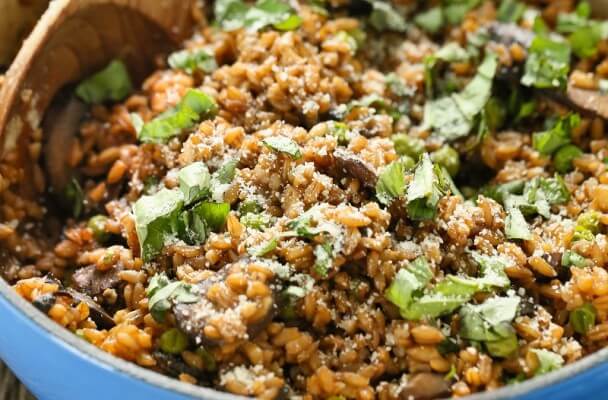
Farro Risotto with Mushrooms Recipe
This farro risotto takes flavor to another level with a blend of mushrooms, herbs, and just a dash of cheese. The result is a filling bowl of hearty food with complex carbohydrates from whole food sources. Try this recipe and you’ll doubtlessly be adding it to your regular rotation!
Ingredients: Organic pearled farro, sliced mushrooms, garlic cloves, extra virgin olive oil, frozen peas, salt, fresh basil, parmesan cheese, hot water.
Total Time: 1 hour, 15 minutes
| Yield: 6 servings
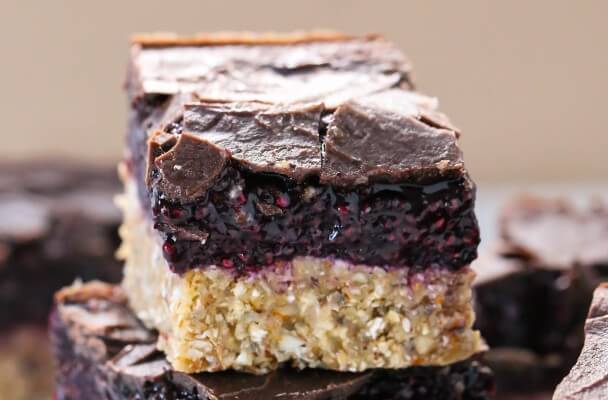
Blueberry Chia Jam Bars Recipe {gluten-free, vegan}
For when your sweet tooth cannot be conquered, assuage your compulsions with a dessert that supplies more carbs than fats with this scrumptious blueberry chia jam bar. The bar features a natural source of sugars in its delightfully sweet topping and a healthful helping of starches in its crumbly base.
Ingredients: Raw almonds, gluten-free rolled oats, chia seeds, maple syrup, water, vanilla or almond extract, blueberries, cacao powder, coconut oil.
Total Time: 30 minutes
| Yield: 16 mini bars
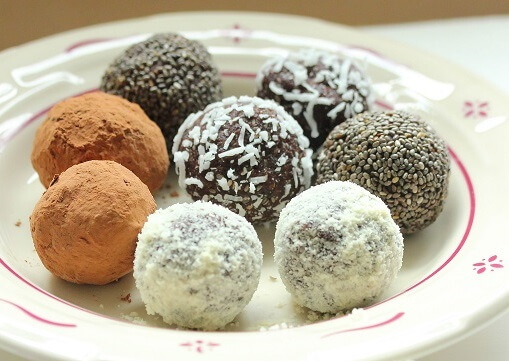
Healthy Vegan Chocolate Truffle Recipe
Another dessert that is sure to delight both your tastebuds and your waistline, these vegan chocolate truffles use the natural sweetness of dates to supply a sweet confection with less than two total grams of fat and zero trans fat while supplying 2 grams of fiber and a gram of protein in each serving.
Ingredients: Jumbo Mejdool dates, almond flour, chia seeds, flaxseed meal, cacao powder, agave or maple syrup, almond milk, unsweetened shredded coconut.
Total Time: 15 minutes
| Yield: 24 truffles
Low-Fat, High-Carb Snacks
The following snacks are whole sources of carbohydrates and contain considerably more carbs than fats, while emphasizing healthier unsaturated fats over other types. We hope you enjoy these nutritious, delicious treats and encourage you to try them all to find your new favorite!
Healthy Eating
- Healthy Snacks
- Healthy Highlights
- 5 Uses for Cacao Powder
- 5 Ways to Eat Farro
- 6 Best Gluten-Free Foods
- Alcohol and the Body
- Almond Flour Recipes
- Anti-Aging Superfoods
- Beat the Afternoon Slump
- Benefits of a Plant-Based Diet
- Benefits of Baobab
- Benefits of Cashews
- Benefits of Coconut Oil for Hair
- Benefits of Coconuts
- Benefits of Dates
- Benefits of Fenugreek
- Benefits of Garcinia Cambogia
- Benefits of Goji Berries
- Benefits of Kale Chips
- Benefits of Monk Fruit Sweetener
- Benefits of Peanuts
- Benefits of Pecans
- Benefits of Pistachios
- Benefits of Pumpkin Seeds
- Benefits of Spelt Flour
- Benefits of Steel Cut Oats
- Benefits of Sunflower Seeds
- Benefits of Tiger Nuts
- Benefits of Turmeric
- Benefits of Walnuts
- Benefits of Wheatgrass
- Best Food Fads
- Cacao vs Cocoa
- Caffeine-Free Energy Foods
- Chocolate That's Good for You
- Diet vs. Exercise
- Fat Burning Foods
- Food Myths Debunked
- Foods for Bone Density
- Foods for Colon Health
- Foods for Healthy Hair
- Foods for Healthy Skin
- Foods to Help Sleep
- Foods to Reduce Stress
- Green Tea Benefits
- Healthy Baking Flours
- Heart Healthy Habits
- High Protein Health Risks
- How to Boost Your Metabolism
- How to Lose Weight While Aging
- How to Throw a Vegan BBQ
- Kaniwa vs Quinoa
- Little Health Foods
- Low-Carb: Fad or Friend?
- Making Healthier Desserts
- Mediterranean Diet Meal Plan
- Natural Beauty Products
- Nuts for Weight Loss
- Preparing Vegan Meals
- Preventing Muscle Degeneration
- Rare Superfoods
- Reduce Sugar Intake
- Save Time By Going Vegan
- Smarter Snack Swaps
- Smoothie Ingredients
- Soy Protein vs Whey Protein
- Starting a Plant-Based Diet
- Steel Cut vs Rolled Oats
- Sugar Substitutes
- Vegan Proteins
- Vegan Substitutions for Fall Recipes
- Why Go Vegan
- Healthy Meals
- Healthy Recipes
- Sports Nutrition
- Vitamins, Minerals & Nutrients

